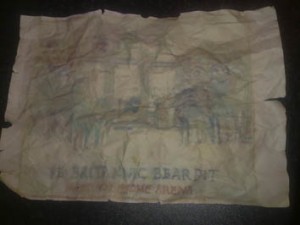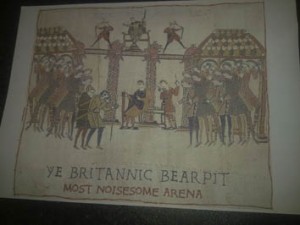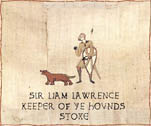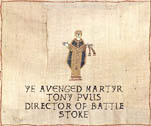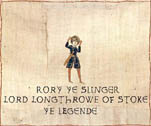The Staffordshire Hoard and Ye Boothen Tapestry
As the largest collection of Anglo-Saxon gold in the country, the discovery of the ‘Staffordshire Hoard’ attracted masses of researchers and historians while creating a media frenzy. A routine cataloging of a peculiar Saxon container, however, has uncovered something even rarer – a genuine Anglo-Saxon tapestry that depicts events that may be eerily familiar to supporters of Stoke City.
Left furled up in the bottom of the container, the tapestry has miraculously managed to remain in legible condition. The first section names the document ‘ye Boothen tapestry’ and goes on to explain that it was commissioned by Penda of Mercia, the 7th Century King of Mercia, to depict the prophecies of a hitherto unknown seer named as ‘Pottæfred’.
While the details are currently indistinct, it would seem that Pottæfred’s subject is a Mercian army that he consistently refers to as ‘Stoke City’. It is initially explained that the tapestry will tell the story of one of the Kingdom’s oldest forces who have a halcyon period before a series of unfortunate events and heavy defeats result in the gradual decay as a fighting unit. What follows is a series of tales that have a remarkable number of parallels with the modern day Stoke City’s rise to the Premier League.
The tales begin as the Viking noblemen who have taken control of the army relinquish their command to ‘merchant Coates’, a local businessman who compensates the Vikings with a decent amount of gold and what is referred to as a ‘mystery sack’. One of the merchant’s first acts is to bring with him the army’s previous battle tactician Anthony Pulis, thought to have been martyred by the Vikings for his unswerving Christian belief in spending hours forcing the locals to observe his silent weekly study of the bible, as opposed to introducing Viking berserkers to put on regular fighting contests.
With this as his starting point, Pottæfred proceeds to chart a series of notable events in the army’s history and even includes special profiles for the more notable soldiers, detailing their role within the army.
Said history undergraduate and Stoke season ticket holder Adam Wootton,
“Naturally, everyone is very excited by this extra find, especially given recent revelations about its content. Initially, we were hoping that it would give us an insight into Saxon life in Mercia under Penda, but instead we’ve recovered a fascinating document that seems to relate to modern events. Perhaps we can work on translating and interpreting the later parts of the text and see what Pottæfred thinks is yet to come. Remarkably, vast sections of the tapestry have survived so hopefully there’s plenty left to work on.”
One key part of the tapestry that has been the subject of much scrutiny and restoration techniques based on those first used by Louis Joubert in the mid 1800’s, is the section entitled “Ye Britannic Bearpit.” This was in a relative poor state of repair (see photo 1 below) when first discovered, but has been carefully reproduced using the Joubert technique to produce a bright clear image. (see photo 2).
Photo 1
Photo 2
The works have been secured for the popular enjoyment of the public by Stoketshirts.co.uk thus preserving this fascinating part of Potters’ history for generation to come.
Other images that have undergone the reconstruction process show other characters that bear amazing similarities to the Stoke City players of today.
As you read this, the restoration work continues and new revelations are being discovered on a daily basis.
